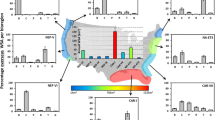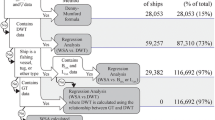Abstract
Niche areas of ships, such as lateral thruster tunnels, sea chests, and propellers, are often hot spots for the accumulation of biofouling organisms, a potential source of aquatic invasive species. Yet, the relative importance of different niche areas is poorly resolved, in terms of both total surface area and the associated biota (i.e., the species of organisms and their abundances). To address this information gap, a method was developed to estimate the extent of various niche areas in the global fleet of 120,252 commercial ships active between 1999 and 2013. The total niche area for these vessels was estimated to be 32,996 × 103 m2, representing approximately 10% of the total wetted surface area (WSA) available for colonization by biota. Considering the portion of niche areas relative to the total WSA, it was highest for passenger vessels (27%), followed by tugs (25%), and fishing vessels (21%), with niche areas representing a small portion of the WSA for bulk carriers and tankers (7–8%). Examining the different types of niche areas, thruster tunnels had the greatest total extent (10,189 × 103 m2), representing a disproportionately large contribution (>50%) of the total niche area for passenger vessels and tugs compared to other vessel types. This result, combined with the use and cleaning of thrusters, may render them “super-hot spots” of biofouling. The uneven distribution and extent of niche areas across vessels has implications for transfers of organisms and management strategies to reduce invasions associated with the surfaces of ships.



Similar content being viewed by others
References
[ABS] American Bureau of Shipping (2014) Ballast water treatment advisory. Houston (TX)
Australian Department of Agriculture (2015) Proposed Australian biofouling management strategies. [updated 2015 Feb 25; cited 2015 Aug 4]. Available from:http://www.agriculture.gov.au/biosecurity/avm/vessels/biofouling
Baier RE, Meyer AE, DePalma VA, King RW, Fornalik MS (1983) Surface microfouling during the induction period. J Heat Transf 105:618–624
Barrass CB (2004) Ship design and performance for masters and mates. Elsevier, Oxford
[CFR] United States Code of Federal Regulations (2003) Protection of environment. Title 40, Pt. 125
Campbell ML, Inti Keith I, Hewitt CL, Dawson TP, Collins K (2015) Evolving marine biosecurity in the Galapagos Islands. Bioinvasions Rec 6(3):227–230
Carlton JT (1987) Patterns of transoceanic marine biological invasions in the Pacific Ocean. Bull Mar Sci 41:452–465
Carlton JS (2007) Marine propellers and propulsion. Butterworth-Heinemann, Oxford
Coutts ADM (1999) Hull fouling as a modern vector for marine biological invasions: investigation of merchant vessels visiting northern Tasmania. Master’s Thesis, Australian Maritime College. Launceston, Tasmania
Coutts ADM, Dodgshun TJ (2007) The nature and extent of organisms in vessel sea-chests: a protected mechanism for marine bioinvasions. Mar Pollut Bull 54:875–886
Coutts ADM, Taylor MD (2004) A preliminary investigation of biosecurity risks associated with biofouling on merchant vessels in New Zealand. N Z J Mar Fresh 38:215–229
Coutts ADM, Moore KM, Hewitt CL (2003) Ships’ sea-chests: an overlooked transfer mechanism for non-indigenous marine species? Mar Pollut Bull 46:1504–1515
Davidson IC, McCann LD, Fofonoff PW, Sytsma MD, Ruiz GM (2008) The potential for hull-mediated species transfers by obsolete ships on their final voyages. Divers Distrib 14:518–529
Davidson IC, Brown CW, Sytsma MD, Ruiz GM (2009) The role of containerships as transfer mechanisms of marine biofouling species. Biofouling 25:645–655
Davidson IC, Ashton G, Ruiz G, Scianni C, Brown C, Lohan KP, Fleischer R (2013) Richness, extent, condition, reproductive status, and parasitism of fouling communities on commercial vessels. Report to the Marine Invasive Species Program of the California State Lands Commission, Sacramento
Davidson IC, Scianni C, Ceballos L, Zabin C, Ashton G, Ruiz G (2014) Evaluating ship biofouling and emerging management tools for reducing biofouling-mediated species incursions. Report to the Marine Invasive Species Program of the California State Lands Commission, Sacramento
Decho AW (2000) Microbial biofilms in intertidal systems: an overview. Cont Shelf Res 20:1257–1273
Drake JM, Lodge DM (2007) Hull fouling is a risk factor for intercontinental species exchange in aquatic ecosystems. Aquat Invasions 2(2):121–131
[EMSA] European Maritime Safety Agency (2012) The world merchant fleet 2012: statistics from Equasis. European Maritime Safety Agency. Lisbon
Floerl O, Inglis G, Dey KL, Smith A (2009) The importance of transport hubs in stepping-stone invasions. J Appl Ecol 46:37–45
Gollasch S (2002) The importance of ship hull fouling as a vector of species introductions into the North Sea. Biofouling 18:105–121
Heger R (2005) Dockmaster training manual. Heger Dry Dock, Inc., Holliston
Hewitt C (2002) Distribution and biodiversity of Australian tropical marine bioinvasions. Pac Sci 56:213–222
[IMO] International Maritime Organization (1993) Resolution A.751 (18): Interim standards for ship maneuverability
[IMO] International Maritime Organization (2004) Convention BWM/CONF/36: international convention for the control and management of ships’ ballast water and sediments
[IMO] International Maritime Organization (2011) Resolution MEPC.207(62): guidelines for the control and management of ships’ biofouling
[IMO] International Maritime Organization (2012) MEPC.1/Circ.792: guidance for minimizing the transfer of invasive aquatic species as biofouling (hull fouling) for recreational craft
Lanier F (2014) The lowdown on bottom paint. BoatUS News. Boat Owners Association of The United States. [updated 2014 Jan 3; cited 2015 Apr 2]. Available from: http://www.boatus.com/magazine/2014/april/boat-bottom-paint.asp
Leung B, Drake JM, Lodge DM (2004) Predicting invasions: propagule pressure and the gravity of Allee effects. Ecology 85:1651–1660
Lovell SJ, Drake LA (2009) Tiny stowaways: analyzing the economic benefits of a U.S. Environmental Protection Agency permit regulating ballast water discharges. Environ Manage 43:546–555
MAN Diesel and Turbo (2011) Basic principles of ship propulsion. MAN SE, Munich
[MPI] Ministry of Primary Industries (2014) Biofouling on vessels arriving to New Zealand. CRMS-Bioufoul. Wellington
Molland AF, Turnock SR (2007) Marine rudders and control surfaces—principles, data, design and applications. Butterworth-Heinemann, Oxford
Moser CS, Wier TP, Grant JF, Tamburri MN, Ruiz GN, Miller AW, First MR, Drake LA (2015) Quantifying the total wetted surface area of the world fleet: A first step in determining the potential extent of ships’ biofouling. Biol Invasions. early online
Muirhead JR, MacIsaac HJ (2011) Evaluation of stochastic gravity model selection for use in estimating non-indigenous species dispersal and establishment. Biol Invasions 13:2445–2458
[NBIC] National Ballast Information Clearinghouse (2013) NBIC Online Database. Electronic publication, Smithsonian Environmental Research Center and United States Coast Guard. Available from http://invasions.si.edu/nbic/search.html; searched 2013 Aug 26
[NT] Northern Territory Government information and services (2016) Hull pest inspections for visiting boats. [updated 2016 Mar 31; cited 2016 Dec 30]. Available from: https://nt.gov.au/marine/for-all-harbour-and-boat-users/hull-pest-inspections-for-visiting-boats
Papahānaumokuākea Marine National Monument (2008) Papahānaumokuākea Marine National Monument Management Plan. National Oceanic and Atmospheric Administration, United States Fish and Wildlife Service, Hawaii Department of Land and Natural Resources. Honolulu
Parente J, Daidola JC, Basar NS, Rodi RC (1996) Commercial ship design and fabrication for corrosion control SR-1377. M. Rosenblatt & Son Inc, New York
[PIANC] Permanent International Association of Navigation Congresses (1992) Capability of ship manoeuvring simulation models for approach channels and fairways in harbours: report of working group no. 20 of permanent technical committee II. PIANC Brussels
Pimentel D, Zuniga R, Morrison D (2005) Update on the environmental and economic costs associated with alien-invasive species in the United States. Ecol Econ 52:273–288
Piola R, Conwell C (2010) Vessel biofouling as a vector for the introduction of non-indigenous marine species to New Zealand: Fishing vessels. Biosecurity New Zealand technical paper, Wellington
Ruiz GM, Fofonoff PW, Steves BP, Carlton JT (2015) Invasion history and vector dynamics in coastal marine ecosystems: a North American perspective. Aquat Ecosyst Health Manag 18(3):1–13
Saunders HE (1957) Hydrodynamics in ship design, vol II. The Society of Naval Architects and Marine Engineers, New York
Schultz MP, Bendick ER, Holm ER, Hertel WM (2011) Economic impact of biofouling on a naval surface ship. Biofouling 27(1):87–98
Simberloff D, Von Holle B (1999) Positive interactions of nonindigenous species: invasional meltdown? Biol Inv 1:21–32
Sylvester F, MacIsaac HJ (2010) Is vessel hull fouling an invasion threat to the Great Lakes? Diversity Distrib 16:132–143
Taylor AH, Rigby G (2001) Suggested designs to facilitate improved management and treatment of ballast water on new and existing ships. Department of Agriculture, Fisheries, and Forestry Australia - Research Advisory Group Ballast Water Research and Development Program
Thieme H (1965) Design of ship rudders. Shipbuilding Institute University of Hamburg, Hamburg
Visscher JP (1928) Nature and extent of fouling of ships’ bottoms. Bull Bur Fish 43:193–252
Watson DGM (1998) Practical ship design. Elsevier, Oxford
Williams SL, Davidson IC, Pasari JR, Ashton GV, Carlton JT, Crafton RE, Fontana RE, Grosholz ED, Miller AW, Ruiz GM, Zabin CJ (2013) Managing multiple vectors for marine invasions in an increasingly connected world. Bioscience 63(12):952–966
WorleyParsons Ltd. (2006) Sea water system operations and design features. BHP Billiton LNG International Inc. Melbourne
Zobell CE (1943) The effect of solid surfaces upon bacterial activity. J Bacteriol 46:39–56
Acknowledgements
This work was supported by the University of Maryland Center for Environmental Science (funding agreement 2012–38) and the Maritime Administration (MARAD). We are grateful to Carolyn Junemann (MARAD) for guidance and programmatic support, and we thank Mark Minton (Smithsonian Environmental Research Center) for his insights regarding the shipping data. Likewise, we appreciate advice from Rich Everett (U.S. Coast Guard Office of Environmental Standards) and the data provided from the National Ballast Information Clearinghouse (NBIC). This work was supported by Diane Lysogorski, Former Section Head of NRL Code 6136 and Director of the Center for Corrosion Science and Engineering—Key West, Florida. Finally, the reviews of this manuscript by Edward Lemieux (Director, Code 6139, Naval Research Laboratory), Warren Schultz (Acting Superintendent, Chemistry Division, Naval Research Laboratory), James Carlton, and two anonymous reviewers improved it—thank you.
Author information
Authors and Affiliations
Corresponding author
Electronic supplementary material
Below is the link to the electronic supplementary material.
Rights and permissions
About this article
Cite this article
Moser, C.S., Wier, T.P., First, M.R. et al. Quantifying the extent of niche areas in the global fleet of commercial ships: the potential for “super-hot spots” of biofouling. Biol Invasions 19, 1745–1759 (2017). https://doi.org/10.1007/s10530-017-1386-4
Received:
Accepted:
Published:
Issue Date:
DOI: https://doi.org/10.1007/s10530-017-1386-4




